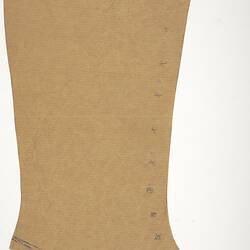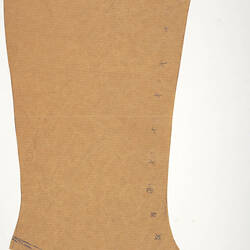Summary
This hand-cut boot pattern has been created on striped brown paper and was most likely used by Stanio Fancoff for creating his various shoes sometime between the 1930s to 1970s. This simple generic pattern with its small sizing suggests that it was probably used within the making of various children's boot styles. Amongst many others, this pattern is part of the shoemaking designer kit that enabled Stanio to acquire versatility and different fashions within his shoemaking trade.
Stanio Ivanoff Fancoff was born in 1908 in Bojentsi, a small village in Bulgaria. At age 11, Stanio left home to learn the shoemaking trade. In 1929, he immigrated to Melbourne, settled in Fitzroy and began to work for the V.G. Zemancheff & Sons basket shoe factory in South Melbourne. In1936, he married Dorotea Georgi Touzou who had recently arrived in Australia. Around this time, Stanio set up his own shoemaking business from home, with Georgi, her cousin and sister weaving the shoes which he then assembled. Select shoe samples were then taken to Sydney and Tasmania for sale. In 1942, Georgi and Stanio moved to Broken Hill for Georgi's health; there daughter Nancy was born and Stanio set up a shoe shop/factory. In 1945, Georgi died and by 1950 Stanio and Nancy had moved to Adelaide where he again opened a shoemaking business and shop. He passed away in 1978, having been in the shoemaking business for 59 years. This collection documents his migration and working life experiences.
Physical Description
This children's boot pattern is created within a side-view perspective. Set within a singular brown paper sheet of striped style, the toe area has been reinforced with a secondary paper piece. The boot's calf area slants at approximately a 45 degree angle to its sole area. The pattern has a short sole length and a pen drawn double-lined sole that extends along the base and up the front edge to finish perpendicular with the boot's toe box. Positioned within the foot-pad area a vertical line extends through the sole and into the shoe area, possibly referencing the sole/upper shoe nail join. Spanning along and set back approximately 1cm from the boot's tongue edge are fourteen penciled cross markings in which the lower six and the top one are encircled, suggesting the lacing eyelets' placements. The pattern's paper appears in good condition with the calf's top back edge being twice folded, and a midway crease mark.
Significance
This collection is significant in documenting a small migrant business as well as the fashion of a particular period. It is well provenanced and charts the application of trade skills in a new country. It also illustrates the stages of hand shoe manufacture from the 1930s, demonstrating the enduring nature of the tools and patterns that were used.
More Information
-
Collecting Areas
-
Acquisition Information
Donation from Nancy Vasileff, 21 Mar 2007
-
Maker
-
Classification
-
Category
-
Discipline
-
Type of item
-
Overall Dimensions
200 mm (Width), 367 mm (Height)
-
References
R.A. Salaman, 'Dictionary of Leather-working Tools c.1700-1950 and Tools of Allied Trades,' London: George Allen and Unwin (Publishers) Ltd, 1986 [Section 2: Boot and Shoe Maker pp18-185]. John Peacock. 'Shoes, The Complete Sourcebook,' London:Thames & Hudson Ltd, 2005. NAA holds file (online) on Vasil George Zemancheff, Fancoff's employer
-
Keywords
Boot & Shoemaking, Bulgarian Communities, Bulgarian Immigration, Immigration, Small Businesses



